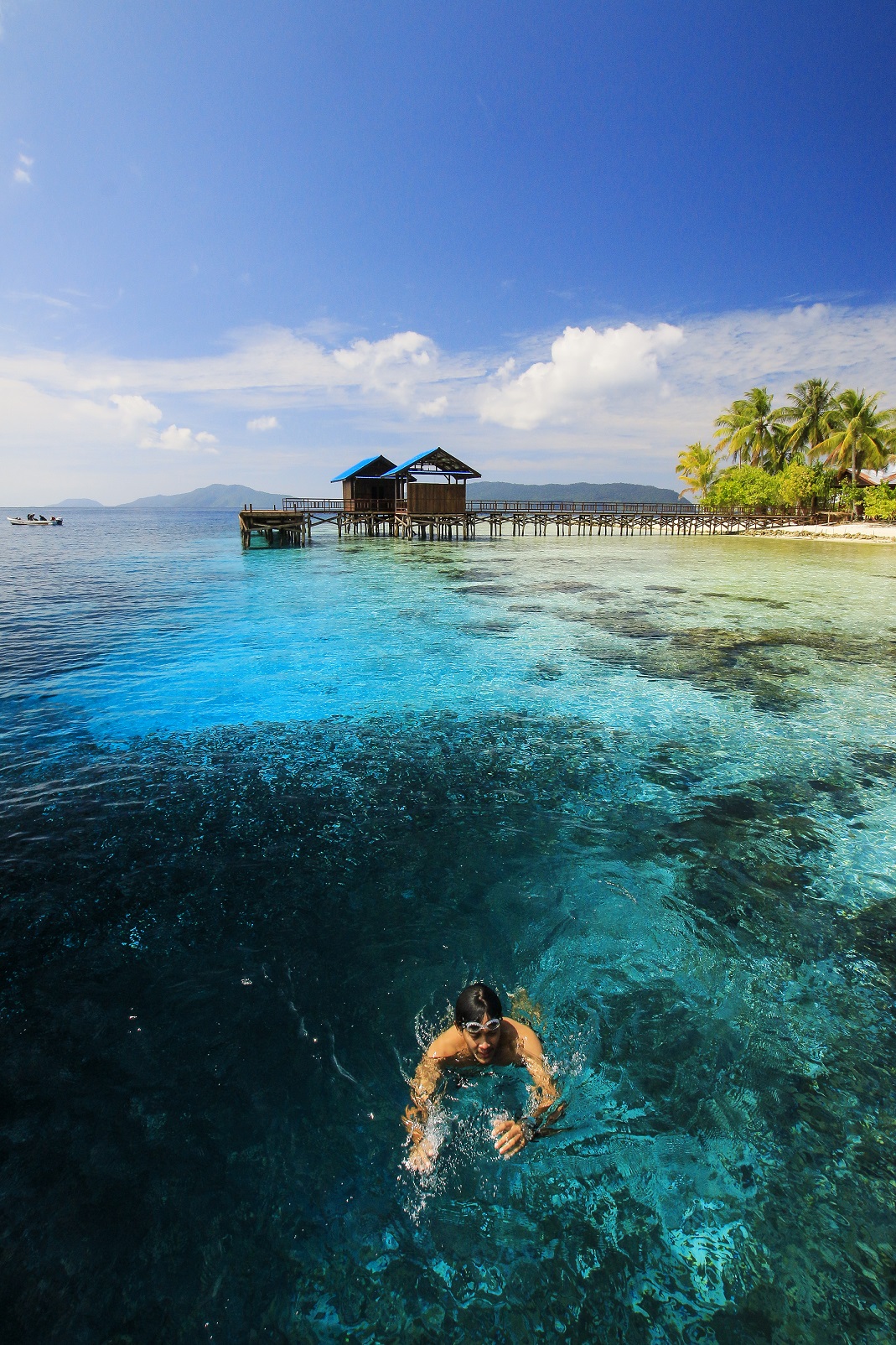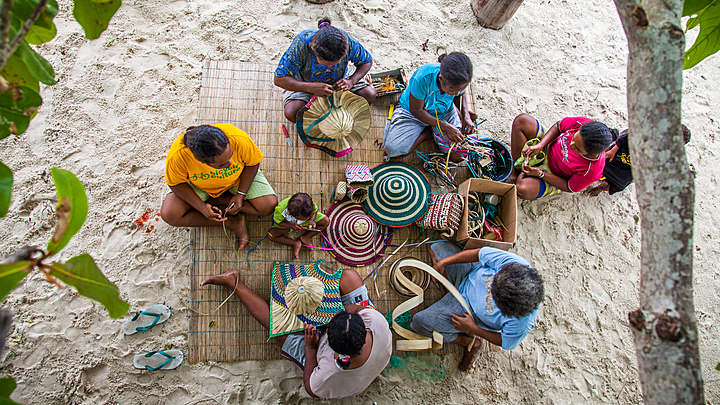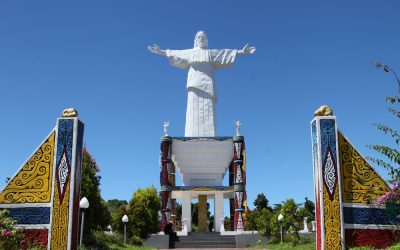Home / Batik Regions – Eastern Indonesia – West Papua / Arborek Village
Cultural Destination
Embrace the spirit of the place!
Arborek Village
Local Communities in Arborek Village, West Papua (photo: @Kostisolo)
Arborek Village
Come and spend some of your time with Arborek people in Raja Ampat. Try their local food and discover their traditional customs including their handicrafts practices. You can also pamper yourself by chilling and taking a bath in a blue ocean. All of these wonderful experiences are waiting to be explored in Arborek village.
Tourist Attractions in West Papua
Mansinam Historical Island
This holy island has been the witness of the two German catholic missionaries who introduced
Raja Ampat National Geopark
Situated in the World’s Triangle Coral Reefs, this region is the king of all
Love Lagoon in Misool
This love lagoon is formed by the natural phenomenon of a mountain lake and
West Papua
Batik Motifs
Raja Ampat
Raja Ampat motif represents the marine life at Raja Ampat archipelago in
Prada Papua
The word “Prada” in the Javanese-Indonesian dialect means a batik textile that
Honai
The Honai is inspired by the traditional house of the Papuan community living in
Burung Cendrawasih
The Cendrawasih bird is believed as sacred Paradise bird that connects the earth with
Discover
Indonesian
Batik
Motifs
Sekar Jati
Sekar means flower and Jati refers to teak trees that symbolizes a strong mental character that
Tampuk Manggis Sasirangan
The motif illustrates the philosophy of the mangosteen fruit, which is
Kain Cual
Cual textile tradition has existed since the 17th century. The word “Cual” refers to
Gurdo Solo
Gurdo or garuda bird is the mount of the Indian god Vishnu. As the Sun Bird,
Gumin Tambun
Based on Hindu mythology, this motif symbolizes lucks, abundant wealth, and
Ukir Sentani
The Ukir motif is a batik motif that is inspired by various traditional Sentani wood carvings
Parang Seling
Parang Seling or “alternating daggers” is a royal batik motif. It is a feminine variant of
Angsa Duo
According to legend, the Angso duo batik motif is a pair of swans that are believed to have led Princess
Tikar Natuna
The Tikar Natuna motif is adapted from the traditional making of pandanus mats in
Pala Salawaku
This motif illustrates the unique weapons of the Maluku region, namely
Parang Rusak
Another meaning behind this motif is an unconquerable spirit, symbolized by
Srimanganti
The name of the Srimanganti motif is derived from Palace’s hallway that connects to
Awan Berarak
Awan Berarak is a combination of Dayak motifs and Malay patterns. The word ‘Awan Berarak’ means the
Gamolan
This motif illustrates Gamolan, a bamboo musical instrument of Lampung that is
Lok Baintan Floating Market
As you can imagine, the most authentic thing is that you can buy things and even
Burung Bidadari
Bidadari birds are endemic birds in Halmahera. This motif represents an
Ikan tambal
The word “Ikan” refers to fish. The philosophical meaning of Ikan Tambal means is
Kaganga Tanah Rejang
If Batik Besurek combines Arabic calligraphy motifs, then the Kaganga batik takes
Kaharingan
The Kaharingan or ‘tree of life’ based on the Dayak tribes’ belief system. This tree symbolizes
Sero Tangga
The Sero Tangga illustrates an endearing feeling and sacrifices of a person to fulfil
Prada Papua
The word “Prada” in the Javanese-Indonesian dialect means a batik textile that
Daun Lada Hitam
The black pepper motif represents the main commodity of Bangka Belitung
Gonggong Siput
Gonggong (Strombus Turturella) is one type of sea snail found around
Tenun Bima
The motifs are adopted from Bima woven textile. This pattern has received a great
Teguh Bersatu
This batik motif shows the strength of the people of Kupang. It also represents a sense of
Tifa Totobuang
The batik motifs illustrate Maluku’s traditional music instrument called
Mahkota Siger
Siger is the crown of a noblewoman in ancient time. It is a symbol of femininity, strength, and
Keluak Daun Pakis
The word “Keluak” is a Minang language which means twisted or tangled. The Motif of
Pohon Hayat (Tree of Life)
The Batik motifs in Lampung are dominated by the acculturation of Buddhist and
Sido Mulyo
Sidomulyo is one of the classical motifs, which is specifically used for the bride’s costume in
Raja Ampat
Raja Ampat motif represents the marine life at Raja Ampat archipelago in
Cengkeh
The clove flower motif is the main commodity of the Tolitoli Regency. This motif represents
Gajah Way Kambas
The motif illustrates the Lampung’s natural reserve, the Way Kambas. it also symbolizes
Besurek Rafflesia
The term “Basurek” refers to a textile that contains letters or inscriptions
Daun Simpor
This motif is inspired by the Simpor plant (Dillenia Suffruticosa) which is a typical
Hiu Taliyasan
Indonesia is also home to the world’s largest fish, the whale shark (Rhincodon typus). Hiu Taliyasan refers to
Durian Pecah
Broken Durian motifs depict the foundation of faith. The second half signifies the mastery of
Tongkonan
Toraja’s traditional house is called Tongkonan. Tongkonan is a place for
Gentala Arasy
Built as high as 80 meters, the tower also highlights the historical side of
Wirasat
Wirasat or divine inspiration is a gift from God. This inspiration is symbolized by
Rumah Mamuju
the Batik motif illustrates the house of Mamuju King with the stairs, located on the left of the wooden stage house
Leuit Sijimat
This motif reflects the daily activities of the Baduy tribe in Banten. The main ornaments of batik motif consist of:
Taiganja
Taiganja is a precious gold pendant that shows the social status of the Kaili family. It is
Honai
The Honai is inspired by the traditional house of the Papuan community living in
Karawo Mahkuta
Mahkuta refers to Gorontalo’s traditional crown. It represents noble characters of
Lipaq Sabe
Lipaq Saqbe contains a simple geometric classical motif with various flower decorations. This textile is
Kasih Tak Sampai
‘Kasih Tak Sampai’ is an idiom in the Indonesian language which refers to
Bekantan Pakis
This motif represents Pakis Haji (Polystichum setiferum), an endemic plant in
Enggang Dayak
Local people beliefs that hornbills are an incarnation of the Commander of the Birds. It has supernatural
Kawung
The Kawung motif was created by Sultan Agung Hanyokrokusumo (1593 – 1645) as a symbolic gift for
Dayak Taghol
Dayak Taghol has a distinctive style of four curved lines and small dots. This motif represents
Tengkawang Ampiek
With its many advantages, the Dayaks use this leaf in ritual ceremonies. This plant is a symbol of
Biji Kopi
The coffee seeds motif illustrates the pride of local coffee specialities in
Merak Ngeram
The hatching peacock motif has a very deep meaning which refers to the sacrifice and
Salakanagara
Salakanagara batik motif illustrates the first kingdom in the Betawi land
Pinawetengan
The Pinawetengan Batik pattern was taken from a prehistoric inscription in
Tabir Tanjung
Tanjung flower is a type of Cherry tree flower, which is commonly found in
Gonggong Beruntun
This motif illustrates that a person should maintain a positive attitude and
Jupri Kembang Teh
Kembang Teh illustrates the tendrils of tea plants that grow in the highlands of
Bomba Mawar
This motif means sacred love for family, kingdom, and God; It also illustrates
Kuda Kupang
Horses symbolize wealth. It contains noble values of virtuous characters that bring
Jumputan Bintang
The word Jumputan means the tie-dye technique, while the word “Bintang” refers to
Wakatobi
It symbolizes the coastal beauty of the Wakatobi island and the symbol of Patra symbolizes
La Galigo
La Galigo is a literary work of the Buginese Epic that has 300 thousand epic lines. It is considered even
Kerawang Tegak Aceh
The Vertical Upright (Kerawang Tegak) Motif symbolizes a person who has a strong
Karawo Pinang
Pinang refers to the Palm areca tree. This motif is considered as the original
Gorga Simeol-Meol
The Gorga Simeol-meol is a pattern of plant tendrils. it is regarded as a symbol of longevity and
Paqbarre Allo
The word “Barre” means round and “Allo” means the sunlight. This motif is interpreted as
Pati-Pati Pinehiku
It symbolizes the hierarchy in society and the social status of the Mekongga
Singayaksa
The Singayaksa motif comes from the name of a place where Sultan Hasanuddin used to
Ake Patra
Ake is related to the divinity and the composition of the universe. It is a symbol of
Gigi Haruan Lidi
The Gigi Haruan Lidi motif is taken from the name of the cork fish and is a symbol of
Sandeq
Sandeq Boat is a symbol of the maritime importance of the West Sulawesi region. The greatness of
Malinau Cultural Festival
You will witness a unique competition that might not be found other than in
Besurek Rembulan
This batik illustrates praise for God who created the wonderful universe





